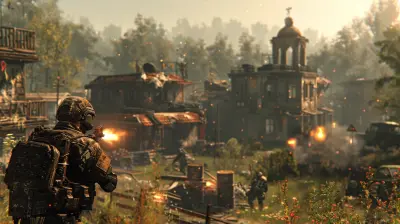The Evolution of Soccer Games: From Pixels to Pro
13 August 2025
Soccer—it's the world's game, no doubt about that. And if you're anything like me, you’ve probably spent countless hours glued to a screen, guiding pixelated players across digital fields. But ever stopped to think about how far we've come in the world of soccer games? I mean, we've gone from chunky pixels to near photo-realistic graphics in what feels like the blink of an eye. It’s been a wild ride, and today, we're kicking off a deep dive into the evolution of soccer games.
So grab your metaphorical cleats, because we're about to dribble through a timeline of innovation, nostalgia, and jaw-dropping progress. Ready? Let’s kick this off (pun 100% intended).![]()
The Glorious Pixelated Beginnings
Once upon a time, soccer games weren’t about lifelike graphics, immense gameplay depth, or online multiplayer tournaments. Nope, they were simple, blocky, and if I’m being honest, hilariously basic. But you know what? They were groundbreaking for their time.Pong’s Legacy on Early Soccer Games
Picture yourself in the 1970s. The video game world was still in its infancy, and Pong was the reigning champion of entertainment. Inspired by its success, developers tried their hand at creating sports games. Enter Pele’s Soccer (1981) on the Atari 2600.Let me paint you a picture: the ball was a square, the players were stick figures, and the goal looked like a couple of glorified rectangles. Yet somehow, it worked. Back then, it wasn’t about realism—it was about the thrill of controlling the game.
Who cared if the players were indistinguishable blobs of color? You were playing soccer on your TV screen. That was the dream. ![]()
8-Bit Glory: The Nintendo Era
By the mid-1980s, soccer games grew just a smidge fancier (but only a smidge). We’re talking NES graphics here—pixel art that had a charm all its own. Titles like Goal! and Tecmo Cup Soccer Game changed the game (pun intended again, sorry).The Rise of Story-Driven Sports Games
One notable innovation? Developers started slapping stories into these games. I know, right? Imagine playing a soccer match and suddenly feeling like you're part of an underdog sports movie. Tecmo Cup Soccer Game did exactly that, weaving in RPG-like elements where players could improve their stats and rise to glory.It was like giving players a coach’s whistle and saying, "Go make your team unstoppable." ![]()
The Isometric View Revolution
The 1990s can be summed up in one word: innovation. This was the decade where soccer games went from clunky to… less clunky. A huge leap came with the introduction of Sensible Soccer and Kick-Off series.Why Was Isometric View Such a Big Deal?
I know what you’re thinking: “What’s an isometric view, and why should I care?” Well, imagine playing soccer with a bird’s-eye view, but tilted slightly so that you could see more of the field. It was like upgrading from watching a game through a keyhole to having your own press box.Sensible Soccer, released in 1992, nailed this perspective. It was fast-paced, strategic, and downright addictive. If you chat with anyone who gamed in the ’90s, chances are they'll light up at the words “Sensi Soccer.” Honestly, it wasn’t just a game—it was a cultural phenomenon. ![]()
FIFA’s Dominance and PES’s Rivalry
Then came FIFA International Soccer in 1993. Yes, that FIFA. The one that seems to have a new installment every time you blink. What made FIFA stand out was its focus on realism. The gameplay wasn’t just fast or fun—it felt authentic.PES (Pro Evolution Soccer) Enters the Pitch
By the early 2000s, FIFA had some serious competition: Pro Evolution Soccer (or PES, as the cool kids call it). While FIFA leaned into its official licensing and glitzy presentation, PES focused on gameplay mechanics.It was the classic tale of David vs. Goliath. And if you ask hardcore fans, they'll tell you PES's gameplay had a certain magic—a fluidity and realism that FIFA just couldn’t match. (Cue heated arguments in gaming forums.)
The Online Multiplayer Boom
Fast forward to the mid-2000s, and something game-changing (literally) happened: online multiplayer. For years, soccer games were all about couch co-op—grabbing a buddy, plugging in two controllers, and duking it out for bragging rights. But thanks to Xbox Live and PlayStation’s online services, suddenly, you could face off against someone halfway across the globe.FIFA Ultimate Team: A Game-Changer
We can’t talk about modern soccer games without mentioning FIFA Ultimate Team (FUT). Introduced in FIFA 09, FUT took the soccer gaming world by storm. Essentially, it’s a mode where you build your dream team by collecting player cards.The catch? Those cards often come from packs, which cost in-game currency or real money. (Yep, microtransactions became the new frontier. Controversial? Absolutely. Popular? Oh, 100%.)
From Graphics to Gameplay: The Current State of Soccer Games
These days, soccer games are a marvel. We’re talking about ultra-realistic graphics, motion-captured animations, and AI so smart you’d think it’s ready to coach a real-life team.Hyperrealism Takes Center Stage
If you’ve played recent FIFA or eFootball (rebranded from PES) titles, you’ve probably done a double-take at how realistic they look. The sweat on players’ brows, the blades of grass on the pitch—even the way jerseys ripple in the wind—it’s pure eye candy.Esports and Streaming
And let’s not forget the rise of esports. Competitive gaming has turned soccer titles into something bigger than just a hobby. Streamers and pro players now battle it out in tournaments with massive prize pools. It’s like the World Cup—but digital.The Future of Soccer Games
Where do we go from here? I wouldn’t be surprised if VR (virtual reality) takes the center stage. Imagine strapping on a headset and stepping into the shoes of your favorite player. You’d see the crowd roaring, feel the pressure of taking that game-deciding penalty, and maybe even get a post-match interview (if you’re lucky).AI and Machine Learning
There’s also talk about integrating AI and machine learning into future games. The idea? AI that learns your playing style and adapts. So if you’re someone who always hugs the sidelines or pulls off ridiculously cheeky through-balls, the game will evolve to match your tactics.Final Whistle
Soccer games have come a ridiculously long way—from blocky stick figures to digital athletes who could easily pass as real. And while nostalgia keeps us fondly remembering those simpler times, it’s hard not to get excited about what the future holds.One thing’s for sure: whether you call it soccer or football, there’s no denying the universal appeal of the beautiful game, even in its digital form. So, here’s to the next evolution—who knows, maybe one day we’ll have holograms playing on our coffee tables.
all images in this post were generated using AI tools
Category:
Sports GamesAuthor:

Leif Coleman
Discussion
rate this article
1 comments
Cassian Thompson
Insightful article on soccer game's impressive journey!
August 22, 2025 at 4:53 AM

Leif Coleman
Thank you! I'm glad you found the article insightful!

